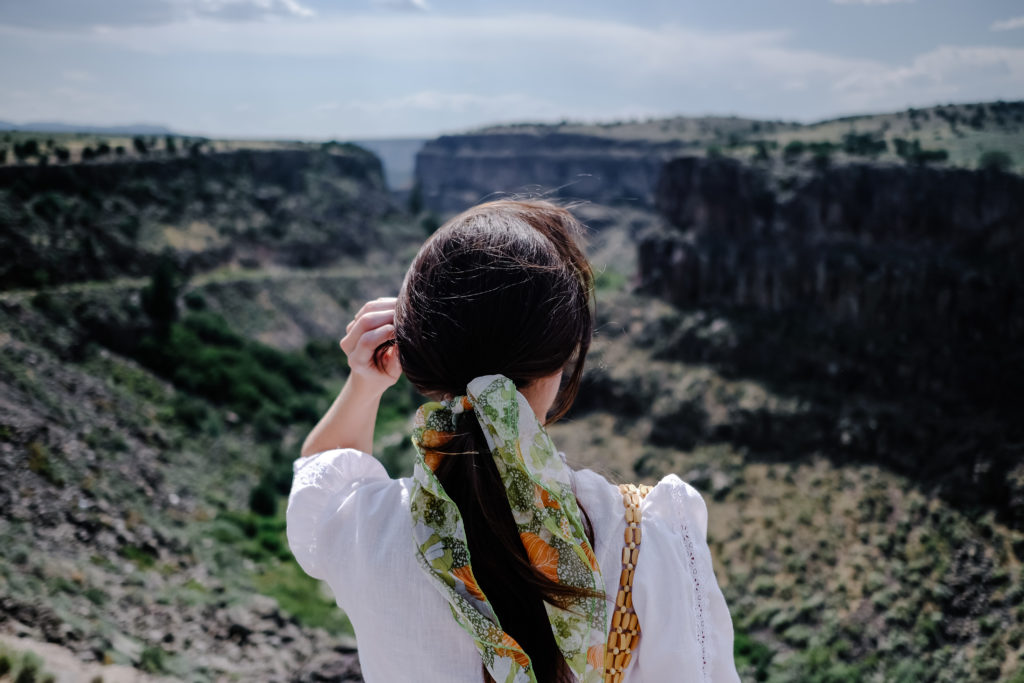
Top: Fair Season | Scarf: Thrifted
Hello! I am Kristine Claghorn. As the owner of a vintage shop, I’m often reflecting on the relationship between objects and their impact on our environment. The more I research, the more opportunities I find to introduce small, thoughtful changes into my daily routine that focus on sustainability. So when I recently started planning a trip from Los Angeles to New Mexico, I couldn’t help but keep this at the forefront of my mind.
Travel can offer many unique challenges to making sustainable choices with your wardrobe. It can also help sharpen your skills as you work within the limitations of carry-on luggage. Sustainable fashion is about more than shopping for brands that broadcast their commitment to the cause. It is about thoughtful, intentional choices like planning ahead for the weather, or simply refraining from overpacking.
Hat: The Magic Hat | Dress: Vintage, similar one available on Cabin | Bag: Cabin
Let’s be honest, we’re all guilty of packing several outfits we might wear but are totally unreasonable for the trip we have planned. Did you know that the more weight there is on a plane or in the car, the more fuel consumption is required? You can reduce your carbon footprint simply by packing minimally and light. Choosing items you can mix and match and that you know you can get more than one wear out of is key.
Already know it’s going to be warm where you’re heading? You don’t need to bring all of your favorite pairs of pants. Want to bring that dress that wrinkles the moment you try to sit down? We all know it’s going to end up crumpled in a sad ball at the bottom of your suitcase. Unless you have a lot of time and an iron, that piece is probably going to stay there for the duration of the trip, reminding you of that space you could have saved.
Dress: Elizabeth Suzann | Travel Mug: Huskee | Clutch: Cabin | Shoes: Allbirds
Sustainable Shopping Basics
Vintage and/or secondhand clothing is the best option.
Why? Buying secondhand clothing means keeping a new item from having to be created. The fashion industry is one of the heaviest sources of pollution worldwide, so closing the gap of constant production is huge. An estimated 15% of clothing is donated each year, which the EPA estimates is the equivalent to taking over a million cars off of the road!
If you are ready to say goodbye to some items in your closet, hosting a clothing swap before donating your items to a charity is another way to make sure your clothing stays out of the landfill.
If you’re buying something new, ask questions.
Are their production practices sustainable and ethical? Most brands that have positive practices will have the information readily available. If you don’t see it, don’t be afraid to shoot them an email. You can also look into Ebay, Depop, or Poshmark to see if the piece you’re looking for is being sold second hand!
Choose natural fibers when you can.
Clothing made from natural fibers are able to return to the earth more easily without causing pollution. Synthetic fibers include plastic, which escapes into our waterways when they go through the wash. Most of the plastic that is polluting our oceans isn’t from straws or single-use plastic, it actually originates from our clothing. For your synthetic items, try using a Guppy Friend or a Cora Ball to keep microplastics from leaching into our waterways.
Top: Whimsy & Row | Bottoms: Vintage Levi’s from Mixed Business | Purse: Thrifted
Avoid trends. Buy timeless pieces you’ll wear for years to come.
Seasons in fashion used to only happen twice per year. Now they happen year-round! It’s hard to avoid the incessant push for new clothing (especially with social media and influencer culture), but once you shift your efforts to only buying pieces that truly feel timeless for you as an individual, it becomes easier to ignore.
Last November, I forced myself to stop buying brand new clothing for 6 months. It helped me change the way I thought about clothing and made me less impulsive with my purchases. Now I resist being impulsive and think much more carefully about buying new items, considering how long each new item I buy might last.
Avoid buying fast fashion at all costs.
The mass production of cheap clothing is a massive waste of resources. Fast-fashion pieces (think Forever 21 and H&M) are so poorly made that they start to fall apart after a couple of wears (and they’re meant to so that you keep buying new pieces)!
Because they are so hard to resell or repurpose, fast fashion items usually end up in a landfill. Here, they produce high amounts of methane and carbon dioxide that eventually pollute our atmosphere. The chemicals and microplastics in their fibers also make their way into our soil and water. NO GOOD.
Top + Chore Coat: Cabin | Bottoms: Everlane
5 Ways to Pack More Sustainably
Limit yourself to a carry-on bag.
The less you pack, the smaller your carbon footprint. Starting off with a smaller bag means you’ll think harder about the pieces you really want to bring. I personally like to leave as much empty room in my carry-on as possible in case I find things I love on my trip (I own a vintage shop after all).
Look at the weather!
This tip may seem obvious, but we’ve all made the mistake of packing for the wrong climate. One time I checked the forecast for San Francisco a week before my trip thinking that would suffice. It ended up being about fifteen degrees colder and rainy than I thought, and I packed mostly dresses (and nothing waterproof).
It’s also important to be practical when it comes to the weather. You might have a piece you really want to wear, but how much sense does it make where you’re going? I had a new vintage dress that I couldn’t wait to wear to New Mexico, but I last minute decided to remove it from my bag. I couldn’t have been happier with that decision because I had room to buy a pair of secondhand shoes that I found during the trip.
Dress: Christy Dawn | Purse: Cabin | Shoes: Avarcas
Mix and match.
Packing outfits for a trip and can be both fun and challenging, like Tetris on speed. I suggest trying things on before deciding what to bring. It helps get the creative juices flowing, and I start to pull out pieces that I know will look good together. For example, I may be tempted to bring my rust-colored sailor pants instead of my neutral slacks that go with everything. Once I lay the options out, the answer becomes clear!
Pack items that you know you can wear more than once before washing.
Choosing outfits that have a longer life of wear helps when you’re trying to travel light. Do you have a dress or blouse that works dressed up or down? That can survive being shoved in a bag without being wrinkled into oblivion? Those pieces will be your best friends. You will thank yourself for bringing them along.
Pack ahead of time using a list.
When you make yourself a packing list and don’t wait until the last minute to pack, it keeps you from throwing unnecessary items into the mix out of sheer panic. It also keeps you from forgetting your underwear.
Top + Shorts: Rawson | Necklace: GLDN
Lastly, it’s important not to be hard on yourself. Shifting areas of your life to be more sustainable can be really eye-opening, and change is never simple or comfortable at first. It is easy to feel like you’re doing everything wrong, but that just confirms you’re making strides! Just remember that we’re all human, and we all make mistakes, like packing shirts and forgetting a pair of pants (yes, I have done that before).
I hope the above tips help you decide how to fill your closet and your suitcase! Once you start to buy and pack less, you’ll feel unexpected freedom with that space. Trust me! Your closet, suitcase, and the earth will thank you.
Dress: Baserange
Kristine Claghorn is a creative producer and owner of the online vintage shop, Cabin. She lives in Los Angeles by way of Indiana, so she’s a Midwesterner at heart. She is dedicated to learning to live sustainably and helping others do the same.
Photos edited with the Local Milk Instagram Collection Presets. You can find and purchase the preset collections here.
My name is Beth, Elizabeth Evelyn to be exact. A native Tennessean, I was born in the South.
I am the author behind Local Milk Blog.









